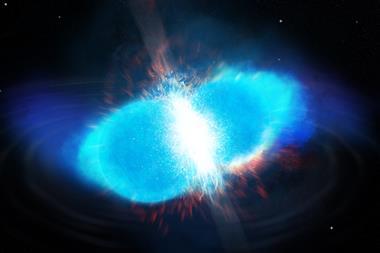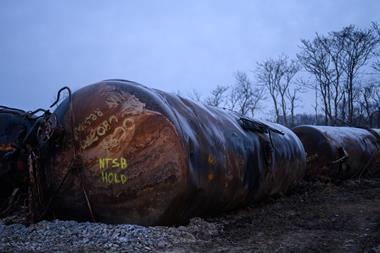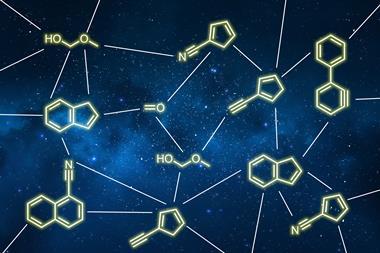Tim Wogan looks at what recent astronomical discoveries have added to our understanding of stellar nucleosynthesis, and the mysteries that remain
On 17 August 2017, tiny, sequential fluctuations in the relative arm lengths of the two detectors of Ligo (the Laser Interferometer Gravitational Wave Observatory) signalled passing gravitational waves. This was the ninth time such oscillations in the fabric of spacetime itself had been recorded since gravitational waves had first been seen in September 2015. Unlike previous detections from merging black holes, however, which had otherwise been invisible, this event from merging neutron stars had an accompanying light show. What astronomers observed in the next few days and weeks would revolutionise scientists’ understanding of the origins of heavy nuclei such as gold, uranium and plutonium. Four years later much still remains shrouded in mystery, but many researchers hope clarity is not too far away.
At the core of nuclear physics lies a tug of war between two of the four fundamental forces: on one side, the strong nuclear force acts to hold the nucleus together by binding the protons to the neutrons; on the other, electromagnetism acts to blow it apart by repelling the positively charged protons. The strong nuclear force is the strongest force in nature, and in the lighter, smaller nuclei it easily wins out, making nuclear fusion of these elements highly exothermic. It is this reaction that fuels stars: the Sun currently generates its energy by fusing hydrogen into helium. Towards the end of its life, models suggest it will become a red giant and briefly fuse helium into carbon. More massive stars can go on to produce elements such as argon, calcium, titanium and iron. And there the process stops.
The strongest of the forces it may be, but the strong nuclear force only acts over very short distances. The range of the electromagnetic force is infinite, however, despite its strength decaying with distance. As nuclei get larger, therefore, the battle between the two gets more even, and eventually electromagnetism begins to win. Right at the crossing point sits iron-56. Beyond this, nuclear fusion becomes endothermic, and can no longer fuel stellar burning. Various ingenious processes have been developed to produce heavier elements in the laboratory (the heaviest nucleus to date – oganesson-294 – was produced by colliding calcium-48 ions with californium-249 atoms) but just three paths to heavier nuclei are found in nature.
The p-process is a mysterious mechanism that produces around 30 to 35 stable heavy nuclei and many radioactive ones that are proton-rich compared to their parent nuclei. ‘There are still a number of open questions,’ says nuclear astrophysicist Anton Wallner of Australian National University in Canberra and Helmholtz-Zentrum Dresden-Rossendorf in Germany. ‘You need a process, most importantly photodisintegration, which usually involves an intense flux of gamma-rays, and this involves explosive scenarios.’ The ‘p-nuclei’ are only around 1–2% as abundant as other nuclei in any given mass region of the periodic table, but they can nevertheless be important: the recent revision of the half-life of samarium-146 from 103 million years down to 68 million years affected estimates of the age of the solar system. ‘In any case,’ says Wallner, ‘we want to understand the process.’
Hitting a wall
All other nuclei beyond iron are neutron-rich. These are produced by one of two possible types of neutron bombardment. Slow neutron capture (the s-process) principally occurs in stars that have exhausted most of their fuel but are still undergoing nuclear fusion – which emits neutrons – in their interiors. Thermal convection currents transport fused nuclei to the surface, where they are bombarded by these neutrons and occasionally capture one. When a nucleus becomes too neutron-rich, it becomes radioactive and may undergo beta decay. This converts a neutron to a proton, increasing the atomic number by one. If the resulting nucleus is sufficiently long lived, it can subsequently capture another neutron. As this process repeats, the atomic number edges gradually upward. The nuclei are released either by stellar winds or when the stars eventually explode in supernovae.
After bismuth-209, however, the s-process hits a wall. Adding an extra neutron gives bismuth-210, which decays to polonium-210. This undergoes alpha decay to lead-206. Further neutron capture simply repeats the cycle. Bismuth is therefore the heaviest ‘stable’ element (it was, in fact, confirmed in 2003 to undergo alpha decay – but with a half-life a billion times the age of the universe).
All elements beyond this require the r-process (rapid process), which involves a very short, extremely intense burst of high-energy neutrons. ‘The regimes are completely different,’ explains Wallner; ‘The s-process takes place with neutron energies of maybe 10–30keV, whereas in the r-process the neutron energies are of order several hundred keV. Different nuclear physics parameters become important because you’re just adding, at an extremely high rate, neutrons and neutrons and neutrons, so the properties of the intermediate nuclei are less important.’ The r-process produces not only all elements beyond bismuth, but around 50% of those between iron and bismuth, with the relative contributions from the s-process and the r-process varying: ‘Gold and platinum, for example, are more produced in the r-process whereas lead is produced more in the s-process,’ Wallner says.
Astronomy’s next top model
Remarkably for such a key process in shaping the universe, where exactly it takes place is still intensely debated. ‘Because of the fact that you require this very high flux of neutrons, it’s clear that you require an extreme astrophysical event,’ explains astrophysicist Brian Metzger of Columbia University and the Flatiron Institute, both in New York City, US. ‘Until a few years ago we really had no idea – the pace at which the most popular models were evolving is an indication of how far we were from converging on an answer.’
In the 1990s, astrophysicists began to suspect that the supernovae of massive stars looked promising. ‘You need an environment with a very high abundance of free neutrons and free neutrons are rare in nature because they decay into protons in 15 minutes,’ explains Metzger. ‘But one way you can make them stable is by compressing them into a neutron star. Back in the day when neutron stars themselves were a bit exotic – let alone smashing them together – people began looking at their birth, which are supernovae. So people were thinking “OK, well if I form this very neutron-rich star, maybe there’s a way to get some of that material out to explain this r-process.”’
This points to a second source, whatever it is
Refined models of conventional supernovae, however, suggest they do not provide enough neutron flux to produce the heaviest r-process elements. Moreover, the hypothesis that s-process and r-process elements originate entirely from a common source seems to contradict experimental evidence. In May 2021, for example, Anton Wallner and colleagues compared the abundance of iron-60 (which is predominantly produced by the s-process and ejected in supernovae) with plutonium-244 (solely produced by the r-process) in samples of the Earth’s crust dating back 10 million years. They found two peaks in the iron-60 abundance – presumably due to nearby supernovae. If the plutonium-244 had also been produced solely by the same supernovae, they should have seen far bigger spikes in the plutonium-244 levels alongside the iron-60 than they actually observed. ‘This points to a second source, whatever it is,’ explains Wallner.
The idea that the source could be neutron star mergers was first suggested in the 1970s, but it was barely discussed until 2010. ‘There was a prominent review article in 2007 where it was a footnote: the rest of the article went through the different supernova channels,’ says Metzger. When Ligo was under construction, however, researchers began to model the physics of mergers more seriously. At this time, gravitational waves had never been detected, and astrophysicists were wondering how they would determine the origin of a signal if they ever were. ‘Partly, this was a community-wide disconnect,’ explains astrophysicist Imre Bartos of the University of Florida in the US. ‘The key driver for this theoretical development was the desire to understand how we would detect gravitational wave sources through other means.’ Then, in 2017, came the bang.
The optical signal following the gravitational wave detection known as GW170817 not only confirmed that the event had been two neutron stars merging to produce a black hole, but the ever-increasing complexity of the spectral lines in the following weeks indicated the production of progressively heavier elements by the r-process. ‘By looking at what we see optically we can reconstruct how much matter was ejected, and this is the key component,’ says Bartos. ‘It’s one thing to say that neutron star collisions can produce these heavy elements, but this first measurement could really be used to put a number on how much matter leaves these systems and compare that to how much we see. There are complexities and complications but the bottom line is that neutron star mergers can explain everything we see in the universe.’
Heavy elements from hypernovae
Not all astrophysicists are convinced. It seems beyond doubt that mergers produce r-process nuclei – especially after several further mergers observed by Ligo have been accompanied by similar electromagnetic radiation – but some astrophysicists argue it is unlikely to be their principal or sole source. Neutron star mergers appear possible only after several generations of star formation and supernovae have produced enough neutron stars. However, relatively large proportions of pure r-process elements have been observed in some stars and galaxies that otherwise contain few elements other than hydrogen and helium – a sign that they were formed in environments where little prior nuclear fusion had occurred. Metzger, an author of one of the key papers identifying heavy elements in the spectra from the 2017 merger, says that ‘maybe [the community] overshot with this one discovery and forgot some of the lessons that people were aware of before’.
I don’t think mergers are the sole site of the r-process
In 2019, Metzger and colleagues postulated that r-process elements could also be produced when rapidly-rotating stars with at least 20–30 times the Sun’s mass collapse in an exotic type of giant supernova (or hypernova). Metzger notes that merging neutron stars and these ‘collapsars’ both produce giant bursts of gamma-rays whose origin once mystified astronomers. ‘What makes the gamma-ray burst in both of these cases is feeding a newly-formed black hole matter at an extremely high rate,’ he says. ‘The process that gives rise to the production of this neutron-rich material is actually outflows from the disc that’s feeding the black hole. There’s a different place in nature where the same physics is happening, and my argument is that if one made the r-process, then the other should as well.’ A key difference between neutron star mergers and collapsars is that not only can young galaxies produce collapsars, but they are more likely to do so than mature galaxies. These events would be much rarer than neutron star mergers, but the overall mass of r-process elements produced in each event could be much greater: ‘I don’t think mergers are the sole site of the r-process,’ Metzger says. ‘Whether they are 99% or 10% or 50% of it will, I think, come into greater focus in future.’
Subsequently, in July 2021 researchers at Australian National University (unconnected to Anton Wallner’s group) and international collaborators focused on a single, highly unusual star containing a large proportion of hydrogen and helium, a very small quantity of iron, and relatively high quantities of the heaviest r-process elements such as europium and thorium. These almost perfectly matched the ejecta predicted by models of the ‘magnetorational hypernova’ of a single, first-generation star 25 times the mass of the Sun, implying that the observed star might have formed from the debris of such an explosion.
These types of hypernovae could produce a collapsar and a gamma-ray burst, but the researchers argue that events which did not form a black hole could still produce r-process elements. The rate of these events – especially in the early universe – could therefore be at least as high as that of neutron star mergers. ‘If you have 1000 supernovae, probably only one of them is this bright one producing gold and uranium,’ says astrophysicist Chiaki Kobayashi of the University of Hertfordshire in the UK. ‘However, compared to neutron star mergers – where you have to have two of them very nearby and get them to merge – it’s not so rare. It’s possible that you could explain 99% of the metals in your mobile phone with these events,’ says Kobayashi.
One model may be better than another at explaining what we see with early stars
Bartos would bet on neutron star mergers being the majority source. ‘We have a source that explains just as much as our best estimate of what we see in the universe,’ he says. ‘It’s not a proof, but at this point the onus is with other sources to prove that they are major contributors.’ He acknowledges that the presence of r-process elements in primitive galaxies is puzzling, but he says ‘that may be something we don’t understand about neutron star mergers – it’s a question of which uncertainty you prefer.’ Moreover, in 2019 he and colleague Szabolcs Marka from Columbia University in New York, US calculated from variations in the abundances of actinide decay products in meteorites that the solar system’s actinides were most likely provided by a single event with approximately the same frequency as neutron star mergers. Bartos concedes that this could, hypothetically, be a type of exotic supernova, but he notes that ‘it requires the fine tuning of the fraction of supernovae that produce heavy elements’.
Anton Wallner says there is still much speculation around. ‘One should be open to the experimental data, present them and discuss with others in the community what they think,’ he says. ‘A majority of the nuclear astrophysics community would be very sceptical of conventional supernovae producing any of the heaviest elements like plutonium or thorium, but maybe there’s just some input in the models that needs to be taken into account. We should not exclude it completely.’
Bartos agrees with Metzger and Wallner that more data are needed. ‘I have my personal opinion on what may be happening, but there are interesting pieces of information supporting collapsars being important contributors versus neutron star mergers being the key source. I don’t think we will be able to conclusively determine this without more gravitational wave detections,’ he says. ‘One model may be better than another at explaining what we see with early stars, and that’s good and it’s important, but it’s not conclusive. When the rate uncertainty, and the ejection amount uncertainty goes down, this will be pretty clear.’ He concludes with a prediction of long it will take to solve the problem: ‘Next five years.’
Tim Wogan is a science writer based in Oregon, US
UPDATE 12 Jan 2022: Imre Bartos’s affiliation has been corrected to the University of Florida

















No comments yet